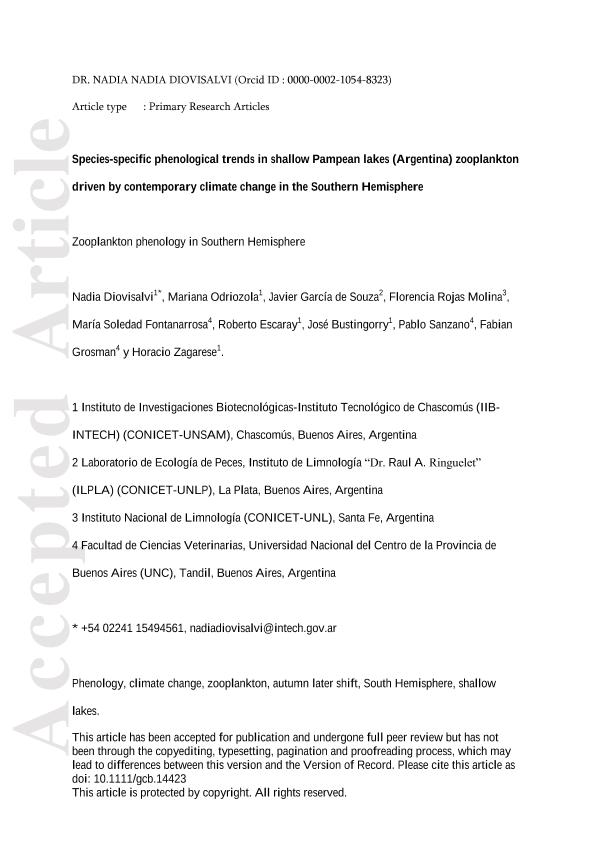Artículo
Species-specific phenological trends in shallow Pampean lakes’ (Argentina) zooplankton driven by contemporary climate change in the Southern Hemisphere
Diovisalvi, Nadia Rosalia ; Odriozola, Mariana Paola
; Odriozola, Mariana Paola ; Garcia de Souza, Javier Ricardo
; Garcia de Souza, Javier Ricardo ; Rojas Molina, Florencia Mercedes
; Rojas Molina, Florencia Mercedes ; Fontanarrosa, María Soledad
; Fontanarrosa, María Soledad ; Escaray, Roberto Ulises
; Escaray, Roberto Ulises ; Bustingorry, Jose Fernando
; Bustingorry, Jose Fernando ; Sanzano, Pablo Miguel; Grosman, Manuel Fabián; Zagarese, Horacio Ernesto
; Sanzano, Pablo Miguel; Grosman, Manuel Fabián; Zagarese, Horacio Ernesto
 ; Odriozola, Mariana Paola
; Odriozola, Mariana Paola ; Garcia de Souza, Javier Ricardo
; Garcia de Souza, Javier Ricardo ; Rojas Molina, Florencia Mercedes
; Rojas Molina, Florencia Mercedes ; Fontanarrosa, María Soledad
; Fontanarrosa, María Soledad ; Escaray, Roberto Ulises
; Escaray, Roberto Ulises ; Bustingorry, Jose Fernando
; Bustingorry, Jose Fernando ; Sanzano, Pablo Miguel; Grosman, Manuel Fabián; Zagarese, Horacio Ernesto
; Sanzano, Pablo Miguel; Grosman, Manuel Fabián; Zagarese, Horacio Ernesto
Fecha de publicación:
11/2018
Editorial:
Wiley Blackwell Publishing, Inc
Revista:
Global Change Biology
ISSN:
1354-1013
Idioma:
Inglés
Tipo de recurso:
Artículo publicado
Clasificación temática:
Resumen
The relationship between the timing of recurrent biological events and seasonal climatic patterns (i.e., phenology) is a crucial ecological process. Changes in phenology are increasingly linked to global climate change. However, current evidence of phenological responses to recent climate change is subjected to substantial regional and seasonal biases. Most available evidence on climate-driven phenological changes comes from Northern Hemisphere (NH) ecosystems and typically involves increases in spring and summer temperatures, which translate into earlier onsets of spring population developments. In the Argentine Pampa region, warming has occurred at a much slower pace than in the NH, and trends are mostly restricted to increases in the minimum temperatures. We used zooplankton abundance data from Lake Chascomús (recorded every two weeks from 2005 to 2015) to evaluate potential changes in phenology. We adopted a sequential screening approach to identify taxa displaying phenological trends and evaluated whether such trends could be associated to observe long-term changes in water temperature. Two zooplankton species displayed significant later shifts in phenology metrics (end date of Brachionus havanaensis seasonal distribution: 31 day/decade, onset and end dates of Keratella americana seasonal distribution: 59 day/decade and 82 day/decade, respectively). The timing of the observed shift in B. havanaensis phenology was coincident with a warming trend in the May lake water temperature (4.7°C per decade). Analysis of abundance versus temperature patterns from six additional shallow Pampean lakes, and evaluation of previous experimental results, provided further evidence that the lake water warming trend in May was responsible for the delayed decline of B. havanaensis populations in autumn. This study is the first report of freshwater zooplankton phenology changes in the Southern Hemisphere (SH).
Archivos asociados
Licencia
Identificadores
Colecciones
Articulos(CCT - LA PLATA)
Articulos de CTRO.CIENTIFICO TECNOL.CONICET - LA PLATA
Articulos de CTRO.CIENTIFICO TECNOL.CONICET - LA PLATA
Articulos(CCT - TANDIL)
Articulos de CTRO CIENTIFICO TECNOLOGICO CONICET - TANDIL
Articulos de CTRO CIENTIFICO TECNOLOGICO CONICET - TANDIL
Articulos(IIB-INTECH)
Articulos de INST.DE INVEST.BIOTECNOLOGICAS - INSTITUTO TECNOLOGICO CHASCOMUS
Articulos de INST.DE INVEST.BIOTECNOLOGICAS - INSTITUTO TECNOLOGICO CHASCOMUS
Articulos(ILPLA)
Articulos de INST.DE LIMNOLOGIA "DR. RAUL A. RINGUELET"
Articulos de INST.DE LIMNOLOGIA "DR. RAUL A. RINGUELET"
Citación
Diovisalvi, Nadia Rosalia; Odriozola, Mariana Paola; Garcia de Souza, Javier Ricardo; Rojas Molina, Florencia Mercedes; Fontanarrosa, María Soledad; et al.; Species-specific phenological trends in shallow Pampean lakes’ (Argentina) zooplankton driven by contemporary climate change in the Southern Hemisphere; Wiley Blackwell Publishing, Inc; Global Change Biology; 24; 11; 11-2018; 5137-5148
Compartir
Altmétricas



